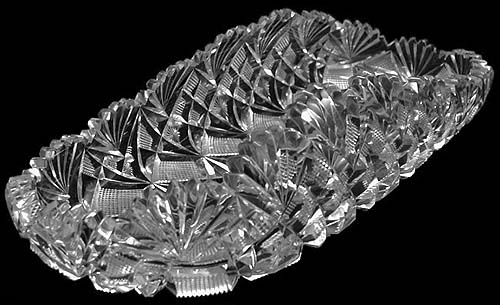

Although one can occasionally find an asymmetrical shape among small dishes -- bon-bons, olives, and the like -- it is more difficult to find a larger item that is asymmetrical. The example illustrated in this file, a foot-long celery tray, appears in the 1893 CATALOG of L. STRAUS & SONS. It has a shape that is fairly well-known among collectors who have, in the past, referred to it as "twisted". Today its official designation, shape no. 313, is used. As the reader will notice, three images are necessary before the actual shape of the celery tray emerges. In the first image the tray appears to be a rectangular, flat-bottomed "boat", unless it is closely examined. The tray's irregularity is more in evidence in the second image where the tray has been rotated about 45 degrees clockwise. To the writer it is the third image, taken from the Straus catalog, that clearly shows the "twisted" appearance of this item. The photographs are good, but sometimes a drawing is more effective.
Celery tray cut in the patented Venetian pattern (1888) on shape no. 313 by L. Straus & Sons. L = 11.5" (29.2 cm), W = 4.5" (11.4 cm), H = 2.75" (7.0 cm). Sold for $265 at an eBay auction in 2002 (Images: Internet).


Shape no. 313, from the 1893 Straus catalog, is shown with the company's Unique pattern:

 The Venetian pattern, close-up on the right, is one of several patterns cut during the early years of the brilliant period that uses curved miter cuts to good effect. Judging by the amount of this pattern found today, it must have been a popular one. Most of it was probably cut during the period 1888-95. Venetian is a symmetrical pattern, readily adaptable to a variety of shapes.
The Venetian pattern, close-up on the right, is one of several patterns cut during the early years of the brilliant period that uses curved miter cuts to good effect. Judging by the amount of this pattern found today, it must have been a popular one. Most of it was probably cut during the period 1888-95. Venetian is a symmetrical pattern, readily adaptable to a variety of shapes.
The Unique pattern, in production by the time of the 1893 catalog, is not often seen. It is the first of several swirl-type patterns made by Straus. They are all asymmetrical and are not as adaptable as the Venetian pattern.
Updated 20 Apr 2004